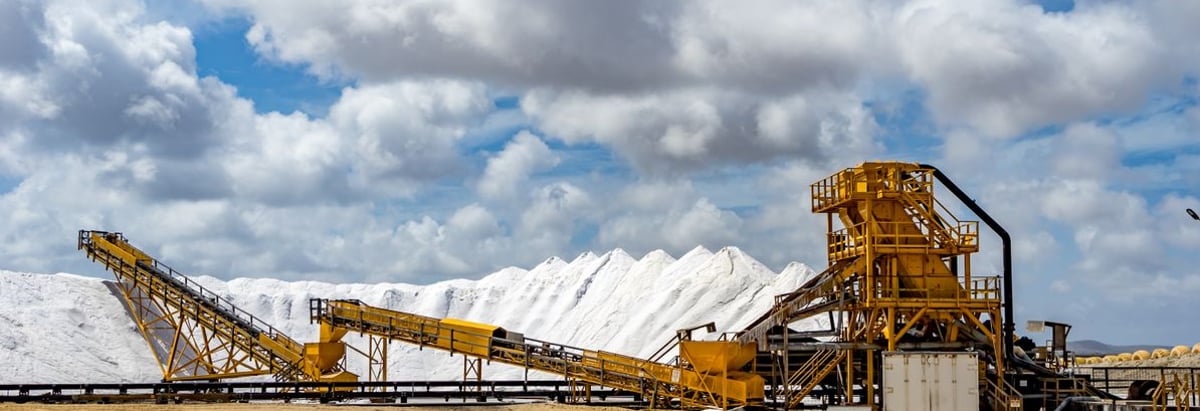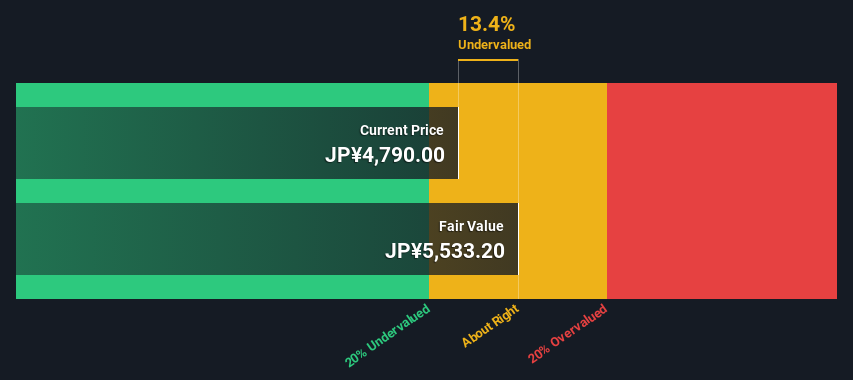- Japan
- /
- Metals and Mining
- /
- TSE:5706
Estimating The Fair Value Of Mitsui Mining & Smelting Co., Ltd. (TSE:5706)

Key Insights
- Mitsui Mining & Smelting's estimated fair value is JP¥5,533 based on 2 Stage Free Cash Flow to Equity
- Current share price of JP¥4,790 suggests Mitsui Mining & Smelting is potentially trading close to its fair value
- Analyst price target for 5706 is JP¥4,843 which is 12% below our fair value estimate
In this article we are going to estimate the intrinsic value of Mitsui Mining & Smelting Co., Ltd. (TSE:5706) by taking the forecast future cash flows of the company and discounting them back to today's value. The Discounted Cash Flow (DCF) model is the tool we will apply to do this. Believe it or not, it's not too difficult to follow, as you'll see from our example!
Remember though, that there are many ways to estimate a company's value, and a DCF is just one method. If you still have some burning questions about this type of valuation, take a look at the Simply Wall St analysis model.
Check out our latest analysis for Mitsui Mining & Smelting
The Calculation
We're using the 2-stage growth model, which simply means we take in account two stages of company's growth. In the initial period the company may have a higher growth rate and the second stage is usually assumed to have a stable growth rate. To start off with, we need to estimate the next ten years of cash flows. Where possible we use analyst estimates, but when these aren't available we extrapolate the previous free cash flow (FCF) from the last estimate or reported value. We assume companies with shrinking free cash flow will slow their rate of shrinkage, and that companies with growing free cash flow will see their growth rate slow, over this period. We do this to reflect that growth tends to slow more in the early years than it does in later years.
A DCF is all about the idea that a dollar in the future is less valuable than a dollar today, so we discount the value of these future cash flows to their estimated value in today's dollars:
10-year free cash flow (FCF) forecast
| 2024 | 2025 | 2026 | 2027 | 2028 | 2029 | 2030 | 2031 | 2032 | 2033 | |
| Levered FCF (¥, Millions) | JP¥14.9b | JP¥12.6b | JP¥14.0b | JP¥15.4b | JP¥24.1b | JP¥28.0b | JP¥30.8b | JP¥32.9b | JP¥34.5b | JP¥35.7b |
| Growth Rate Estimate Source | Analyst x4 | Analyst x3 | Analyst x4 | Analyst x2 | Analyst x2 | Analyst x1 | Est @ 9.83% | Est @ 6.93% | Est @ 4.90% | Est @ 3.48% |
| Present Value (¥, Millions) Discounted @ 8.9% | JP¥13.6k | JP¥10.6k | JP¥10.8k | JP¥10.9k | JP¥15.7k | JP¥16.8k | JP¥16.9k | JP¥16.6k | JP¥16.0k | JP¥15.2k |
("Est" = FCF growth rate estimated by Simply Wall St)
Present Value of 10-year Cash Flow (PVCF) = JP¥143b
After calculating the present value of future cash flows in the initial 10-year period, we need to calculate the Terminal Value, which accounts for all future cash flows beyond the first stage. For a number of reasons a very conservative growth rate is used that cannot exceed that of a country's GDP growth. In this case we have used the 5-year average of the 10-year government bond yield (0.2%) to estimate future growth. In the same way as with the 10-year 'growth' period, we discount future cash flows to today's value, using a cost of equity of 8.9%.
Terminal Value (TV)= FCF2033 × (1 + g) ÷ (r – g) = JP¥36b× (1 + 0.2%) ÷ (8.9%– 0.2%) = JP¥408b
Present Value of Terminal Value (PVTV)= TV / (1 + r)10= JP¥408b÷ ( 1 + 8.9%)10= JP¥173b
The total value is the sum of cash flows for the next ten years plus the discounted terminal value, which results in the Total Equity Value, which in this case is JP¥316b. To get the intrinsic value per share, we divide this by the total number of shares outstanding. Compared to the current share price of JP¥4.8k, the company appears about fair value at a 13% discount to where the stock price trades currently. Valuations are imprecise instruments though, rather like a telescope - move a few degrees and end up in a different galaxy. Do keep this in mind.

The Assumptions
We would point out that the most important inputs to a discounted cash flow are the discount rate and of course the actual cash flows. You don't have to agree with these inputs, I recommend redoing the calculations yourself and playing with them. The DCF also does not consider the possible cyclicality of an industry, or a company's future capital requirements, so it does not give a full picture of a company's potential performance. Given that we are looking at Mitsui Mining & Smelting as potential shareholders, the cost of equity is used as the discount rate, rather than the cost of capital (or weighted average cost of capital, WACC) which accounts for debt. In this calculation we've used 8.9%, which is based on a levered beta of 1.558. Beta is a measure of a stock's volatility, compared to the market as a whole. We get our beta from the industry average beta of globally comparable companies, with an imposed limit between 0.8 and 2.0, which is a reasonable range for a stable business.
SWOT Analysis for Mitsui Mining & Smelting
- Debt is well covered by earnings and cashflows.
- Earnings declined over the past year.
- Dividend is low compared to the top 25% of dividend payers in the Metals and Mining market.
- Annual earnings are forecast to grow faster than the Japanese market.
- Current share price is below our estimate of fair value.
- Dividends are not covered by earnings.
- Annual revenue is forecast to grow slower than the Japanese market.
Next Steps:
Although the valuation of a company is important, it ideally won't be the sole piece of analysis you scrutinize for a company. DCF models are not the be-all and end-all of investment valuation. Instead the best use for a DCF model is to test certain assumptions and theories to see if they would lead to the company being undervalued or overvalued. For example, changes in the company's cost of equity or the risk free rate can significantly impact the valuation. For Mitsui Mining & Smelting, there are three additional elements you should consider:
- Risks: We feel that you should assess the 4 warning signs for Mitsui Mining & Smelting we've flagged before making an investment in the company.
- Future Earnings: How does 5706's growth rate compare to its peers and the wider market? Dig deeper into the analyst consensus number for the upcoming years by interacting with our free analyst growth expectation chart.
- Other Solid Businesses: Low debt, high returns on equity and good past performance are fundamental to a strong business. Why not explore our interactive list of stocks with solid business fundamentals to see if there are other companies you may not have considered!
PS. Simply Wall St updates its DCF calculation for every Japanese stock every day, so if you want to find the intrinsic value of any other stock just search here.
New: Manage All Your Stock Portfolios in One Place
We've created the ultimate portfolio companion for stock investors, and it's free.
• Connect an unlimited number of Portfolios and see your total in one currency
• Be alerted to new Warning Signs or Risks via email or mobile
• Track the Fair Value of your stocks
Have feedback on this article? Concerned about the content? Get in touch with us directly. Alternatively, email editorial-team (at) simplywallst.com.
This article by Simply Wall St is general in nature. We provide commentary based on historical data and analyst forecasts only using an unbiased methodology and our articles are not intended to be financial advice. It does not constitute a recommendation to buy or sell any stock, and does not take account of your objectives, or your financial situation. We aim to bring you long-term focused analysis driven by fundamental data. Note that our analysis may not factor in the latest price-sensitive company announcements or qualitative material. Simply Wall St has no position in any stocks mentioned.
About TSE:5706
Mitsui Mining & Smelting
Engages in the manufacture and sale of nonferrous metal products in Japan and internationally.
Flawless balance sheet with solid track record and pays a dividend.
Market Insights
Community Narratives





